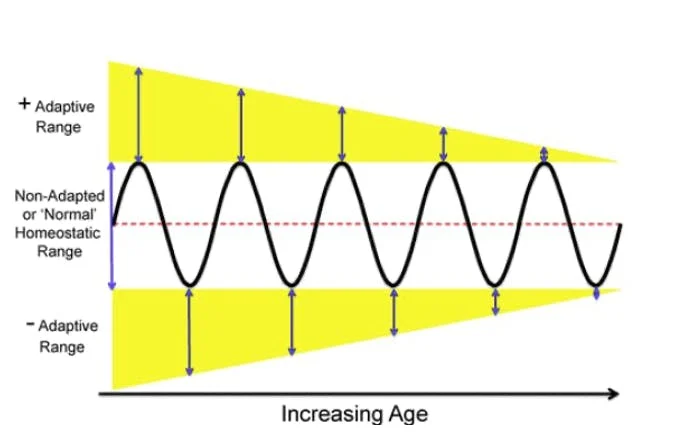Interesting paper on adaptive homeostasis, and the decline in adaptive range in aging. Dr Mike T Nelson talks about physiological flexibility as a goal for fighting off the effects of aging.

“Adaptive homeostasis enables young organisms to quickly activate a plethora of protective responses, depending on the type of signal received. Moreover, in young organisms, with typically relatively low exposure to free radical generation and oxidative damage, the basal levels of expression of various stress‐responsive enzymes is typically quite low. In contrast, aged organisms that have had to cope with a lifetime of both internal and externally derived sources of oxidative damage exhibit higher basal levels of protective enzymes. Unfortunately, the maximal levels of activation of protective systems appears not to change. Thus, the functional range of adaptive homeostasis in older organisms is significantly compressed. Aged organisms must therefore cope with higher levels of chronic low‐grade stress and lack‐lustre induction of compressed adaptive stress responses (Fig. 4).
Physiological Flexibility by Dr Mike T Nelson:
The 4 main regulators pH, temp, blood gas oxygen and CO2, and blood glucose. The 8 interventions (2 for each) are:
- Hot -such as warm temps outside or sauna
- Cold - cold water immersion, cooler temps, cold showers
- HIIT -high intensity exercise as Wingates (aka Beast Mode)
- LISS - as Dr Mike’s buddy Luke from Muscle Nerds calls it “Least Mode” aka lower intensity exercise
- Low blood glucose - via fasting protocols
- High(er) blood glucose challenge - 2 pop tart test
- Slow breathing techniques and breath holds
- Fast (supra ventilation) techniques like Wim Hoff and others
Link to podcast episode: